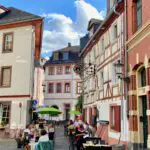You may have prepared well for which wineries you want to visit, but are you ready for which foods you should try while visiting Germany? Are you ready for the next step beyond Currywurst, Eisbein, and Black Forest cake?
If you have ever had the perfect piece of duck with a nice Pinot Noir or a delicious bite of blue cheese with a well-crafted sweet Riesling Auslese, you will agree that great pairings are always better than the bits and sips on their own. It’s like there is this little magic show happening in your mouth turning a 1+1 into a 3.
One of the most basic approaches to good food and wine pairings, and the one I will use in this tour, is to match regional wines with the food the winemaker’s grandmother would have enjoyed. In other words, pairing regional dishes with regional wines.
Let’s take a ride from the southern wine regions to some of the most northern. We will follow the Rhine River all the way from Basel to Koblenz, and then we will take a left into the Moselle. Classic German cuisine is about tasty, filling dishes. (Come back later for modern fine-dining food recommendations.) I won’t offer specific wine advice as there are too many options, but you can visit other posts of mine for this type of advice.
Now, off we go….

Soon after setting off from Basel, we reach the outer fringes of the Schwarzwald to the right. The western slopes form the wine region of BADEN which is increasingly known for some of Germany’s best Pinot Noirs. Have some Käsespätzle with it. This is a local pasta dish served with cheese (think of a baked mac’n’cheese). If passing through in the Spring, try wines from the Müller-Thurgau varietal with White Asparagus dishes or with Badischer Flammkuchen (the region’s super thin version of pizza). For dessert ask for a white Spätlese wine (late harvest) and have it with Öpfelkichle (the region’s apple pancake). If you haven’t had enough yet, this is the region to hunt for a Schwarzwälder (Black Forest Cake), but the cake is better matched to a cup of coffee.
After passing the city of Karlsruhe, the left bank of the Rhine River will turn into the wine area of the PFALZ (internationally known as the Palatinate). This area is well known for Rieslings and the red varietal Dornfelder. The sausage-type dish called Saumagen goes well with either wine although some might prefer it with the crisp and acidic notes of a Riesling. In some cases, preparation will help with matching: it comes in as many variations as there are Bolognese sauces, and it will be served cooked or fried. In autumn, though, you might want to match a nicely oaked Dornfelder to one of the many variations of local game dishes instead.

Further on northbound, the Pfalz gives seamlessly into the region of RHEINHESSEN, Germany’s largest wine region, with the city of Mainz as its unofficial capital. One cannot talk about food in Mainz without mentioning Bretzel in all its incarnations… the American foody will recognise it immediately as the base, the original unadulterated pretzel. Also, there is Spundekäs’ (homemade cream-cheese, sprinkled with small onion cubes and scooped up with small pretzels) and Worscht (think of a Baloney without the fat cubes) which is eaten warm or cold. A simple unsophisticated classic meal in Mainz and the vineyards of the region is the WWW combo: Weck (a roll) with Worscht and Wine (usually a no-fuss, dry white one —try a solid Grauburgunder / Pinot Gris). If one day you help at a harvest, WWW will certainly be part of your lunch.

Just across the Rhine River, we find ourselves at about the latitude of Frankfurt. This is where we meet the RHEINGAU. This is possibly the most famous of all German wine regions and the cradle of German Riesling which is still the dominating variety today. A Harzer Cheese, commonly eaten as Handkäse mit Musik, is one of the region’s specialties. The Handkäse is a sour milk cheese marinated in vinegar, oil, sprinkled with raw onions, caraway seeds, and sometimes served with a large shot of inexpensive Riesling. Its pungent taste evokes only two reactions: love -or hate. Less adventurous travellers might want to match their Rheingau Riesling to a Wisperforelle. This is a locally raised trout often presented with a Riesling sauce.

At the western end of Rheingau, the Rhine River takes a turn northward and enters the famous and romantic Rhine River Valley with its castles, steep slopes, and the rocks of the Loreley. The vineyards are part of the MITTELRHEIN wine region. As in the Rheingau, the region’s most prevalent vine varietal is Riesling followed by a small percentage of Pinot Noir. One of the most remarkable local dishes is Himmel un Äd (literally ‘heaven and earth’): mashed potatoes, apple compote, and fried slices of black pudding. Have it with a young Pinot Noir.
Just out of its spectacular valley, the Rhine will be met by the Mosel River, and we’ll take a left turn to enter the wine region of the same name: MOSEL. In terms of international fame, Mosel Rieslings are at par with Rheingau though more so for its off-dry to sweet Rieslings. Good ‘off-dry’s will balance sweetness with refreshing acidity, so they do go well with various foods. Try them with the local meat dishes like Zwiwwelfleisch (a stew with onions and wine) or Muselfisch (a regional fish fried in a wine-based batter). Finish off your meal with a dessert made with Weinbergpfirsisch (a red vineyard peach which is very particular to the Mosel region) matched to a reasonably sweet Auslese or Beerenauselese Riesling.

A quick word of caution before letting you off on your culinary exploration of the German wine regions…. The recommendations above carry about a triplogazillion calories, so make sure you include a reasonable amount of walking trips into some of the steeper vineyards. Otherwise you might find yourself rolling home!
Have a great journey!
Cover Picture (c) DWI www.deutscheweine.de








